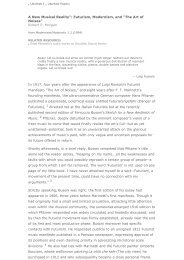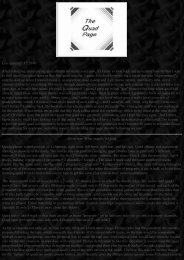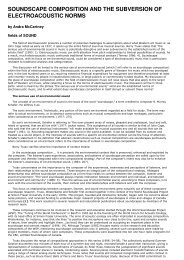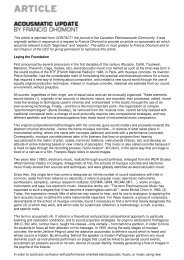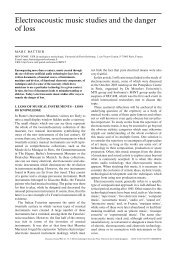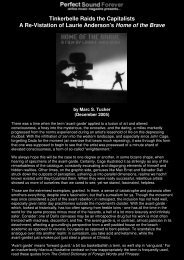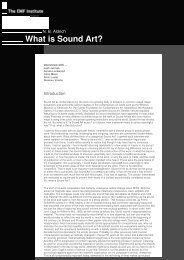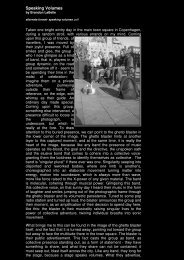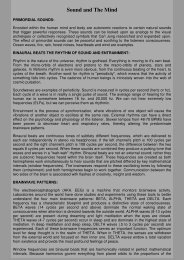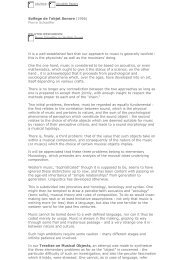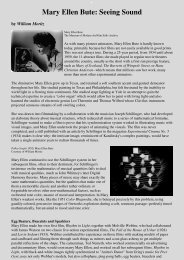Schaeffer_J-1994-6 Elements of Installation.pdf - An International ...
Schaeffer_J-1994-6 Elements of Installation.pdf - An International ...
Schaeffer_J-1994-6 Elements of Installation.pdf - An International ...
- No tags were found...
You also want an ePaper? Increase the reach of your titles
YUMPU automatically turns print PDFs into web optimized ePapers that Google loves.
Time. In relation to this concept, Temporality defines itself as a finite embodiement <strong>of</strong> that space-time. ‘Temporal’ is a wordwhich implies a physical relationship to worldly things as opposed to the spiritual affairs <strong>of</strong> Metaphysics. ‘Temporary’ in its owndefinition talks <strong>of</strong> time as lasting for a limited period, or a defined fraction <strong>of</strong> that Time. Thus the two consummate theirrelationship and become one. As discussed in, ’Element 1’, Physics has shown that matter is born from the vacuum, (that isspace), which then becomes the physical representation <strong>of</strong> Temporality in my analysis. The property <strong>of</strong> Time will then be takento represent the metaphysical notion that it records itself within its own whole."How long is a piece <strong>of</strong> string?" <strong>An</strong>on. This classic phrase introduces the next ingredient to be mixed into the meltingpot. Thisbeing the philosophical consideration <strong>of</strong> the relationship <strong>of</strong> time to the temporal nature <strong>of</strong> some installational works. What doesthe image <strong>of</strong> the word itself conjour up about insallation? You can install something and leave it to exist for seconds, years,decades or for many lifetimes. It can be said that all matter has finite existence therefore everything is temporary, but I wishto talk about <strong>Installation</strong>al temporality, which, to me, suggests the link with hours, weeks and months rather than with years,decades and centuries.In terms <strong>of</strong> Christos work then, temporality becomes essential to the whole. The work itself is only allowed to exist for aforeseeable finite reality, and it is this which helps it to become what it is; a temporary installation. As noted by Marina Vaisey,"The final work questions the whole notion <strong>of</strong> permenance in art, for Christo’s vast environmental sculptures which take place inthe real world, have a deliberatly limited life, for a few days, at the most two weeks" 13. It is Christos installations that excitme, I love his wrapped sculptures, but these live on, and are <strong>of</strong> a human scale. Somehow I can relate better to his ‘massive’sculptures that no longer exist. You can look at memories, and perhaps have an experience <strong>of</strong> that event, but you know that itis now cast in past recorded time (history). This has a direct influence upon your attitude towards it.In the work <strong>of</strong> <strong>An</strong>dy Goldsworthy, I find a real sense <strong>of</strong> excitment. He, as with Christo, enters the many different fields <strong>of</strong>installation. The temporality found within his body <strong>of</strong> work is an expression <strong>of</strong> the cycle <strong>of</strong> nature which is itself a ‘repetitivecycle <strong>of</strong> temporality’.Goldsworthy engages nature on its homeground, working with it to define its beauty, by exposing it through his transitionalprocess. What defines longevity in his work is the work itself. If the materials he uses to produce a piece are stone then it maywell last for years, but if that material is snow on a hill, or sand on a beach,then its lifespan may be days or hours.In the late winter <strong>of</strong> 1988/89, Goldsworthy made eighteen large snowballs (2.1) in Perthshire and then preserved them in coldstorage until July that summer where they were displayed in the Old Museum <strong>of</strong> Transport, Glasgow. There they were laid inline to live out there life. It took a total <strong>of</strong> five days for them to melt, slowly revealing there individual contents throughout thattime, as each snowball was blended with a different element from nature, such as fresh pine needles, or wilowherb stalks."When snow melts things hidden away emerge - evidence <strong>of</strong> time laid on the ground"14. It is this ‘evidence <strong>of</strong> time’ which thepiece deals with, both in terms <strong>of</strong> its manufacture and its temporality. When allowed to react with the summer heat thesnowballs both come alive and begin to die at the same time. Their destiny is determined. The work only exists as it fadesaway. You can visably see the passing <strong>of</strong> time as recorded by their dematerialisation. This is as important to the work as itsprocess.Five days is temporary, and so is 1/60th <strong>of</strong> a second, the rough shutter speed <strong>of</strong> the camera that caught Goldsworthy’sinstallations in space-time when creating, ‘Hazel stick throws’ (2.2), in 1980. Here he created a multitude <strong>of</strong> mini-installationswith each throw <strong>of</strong> the sticks that he made. This is so because the camera only happened to catch just one <strong>of</strong> thesemini-installations, which by implication means that it didn’t catch all the other exact co-ordinates <strong>of</strong> the sticks as they flewthrough gravitational space on their return journey to the ground. This ‘sculpture’ has at its core a real element <strong>of</strong> built inobselecence. There is no way (‘on earth’!) that this fraction in time could set out to be anything but temporary. This is thenperhaps an example <strong>of</strong> installation which is the epitome <strong>of</strong> temporality. Its very inception implies its immediate fate.This ‘built in obselecence’, is also instilled in Matta-Clarks work. The way he works with derelict buildings means that from thefirst touch or even the first thought his work is innevitably destined to be destroyed with the eventual transformation <strong>of</strong> thebuilding into rubble. His interaction with the building also adds to the temporance <strong>of</strong> that building as he frequently underminesits structural stability. He then is part <strong>of</strong> the demolition process, but in a controlled sense. In 1975 he was lucky enough to begiven permission to work with a building located adjacent to the Centre Georges Pompidou during its construction. He setabout burrowing through the walls and floors creating a ‘Conical Intersect’ (2.3) for the Paris Biennial. The house he worked onwas built in 1699 and was one <strong>of</strong> the last proporties due for demolition as part <strong>of</strong> the Pompidou modernizing programme <strong>of</strong> thePlateau Beauborg. The work was as provocative and controversoial as ever ensuring that all who encountered it were forcedinto thought.The same is true <strong>of</strong> Racheal Whitread’s ‘House’. It has been the reactions <strong>of</strong> the public which have helped bring it tointernational attention. Or at least it is these reactions which have made it so controversial. Now that it has been demolishedduring the writting <strong>of</strong> this dissertation it lies in the memory banks <strong>of</strong> society. For me, the destruction <strong>of</strong> ‘House’ was necessaryfor its completion. Many regard its destruction as a negative thing. Whiteread herself did not want it to be destroyed. From itsinception though it was always known that it was going to be destroyed (the role <strong>of</strong> process [Element 5]is important here), aswith a Matta-Clark work. This knowledge <strong>of</strong> its imminent death added to its worth in my opinion. It made people want to goand experience it before its removal. It heightened its existence, as its time was limited. Its temporality added to its ‘worth’, asit helped induce debate and thus its media coverage which brought it to a wider public.Architecture is something that is usually ‘built to last’, for economic reasons more than anything else. It is not usually seen astemporary. Having said this though ‘temporary’ architecture is designed and constructed. The reality <strong>of</strong> this though is that itstays put for much longer than intended. Vienna has a long tradition <strong>of</strong> building temporary structures that were intended toexist for a year or so but in reality have stayed put. Portacabins in schools solved accommadation problems quickly but havelasted well beyond their sell by date in actuality. Buildings are in fact temporal but not in the sense <strong>of</strong> <strong>Installation</strong>altemporality.Temporality can then add to the experience <strong>of</strong> <strong>Installation</strong> Art.It can be a singular part <strong>of</strong> the whole, or the whole itself. I findits gives a real sense <strong>of</strong> excitement to the process <strong>of</strong> involvement in installation. It also excites me when observing the records<strong>of</strong> past temporary installations. The very knowledge that they no longer exist I feel still adds a real sense involvement to theexperience <strong>of</strong> discovering their past history.ELEMENT 3 CEREBRAL



